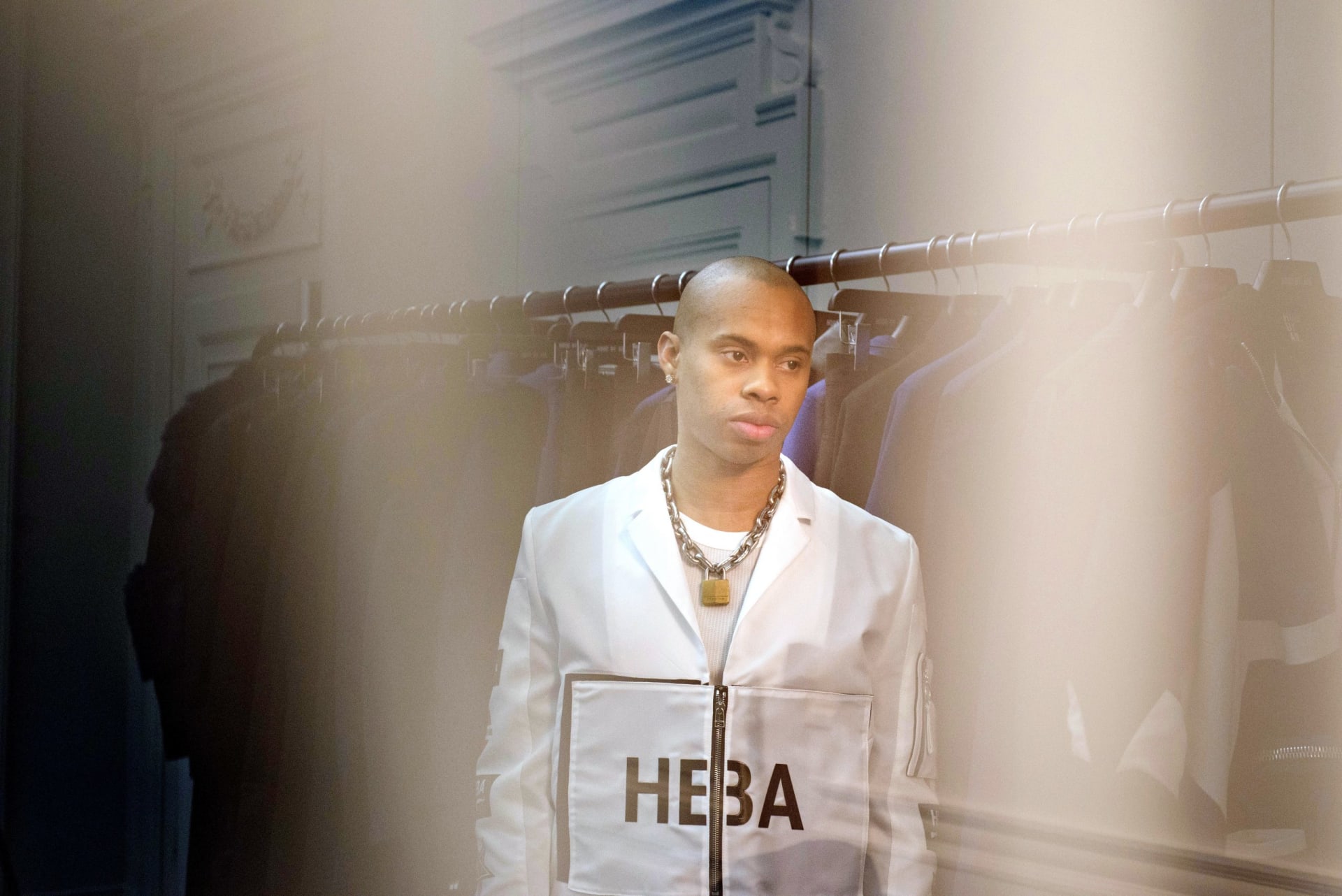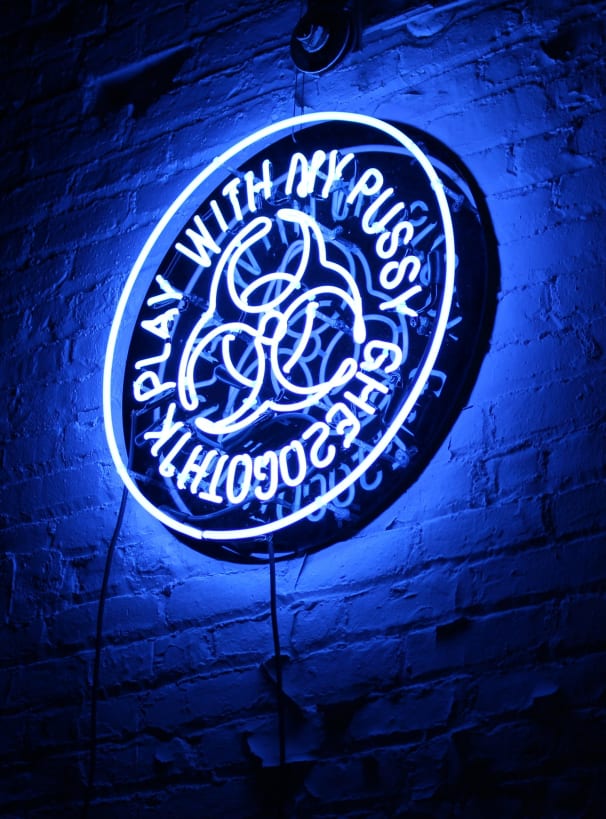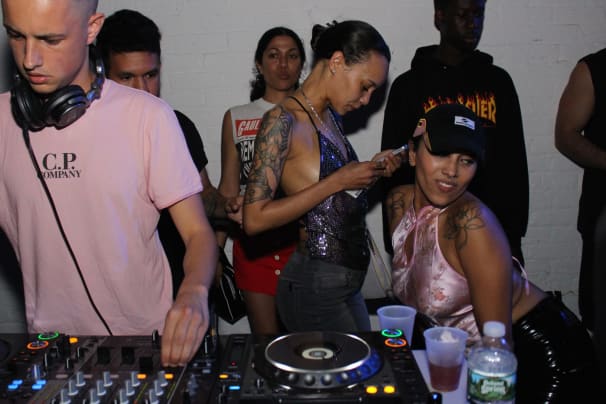
How Hood By Air Harnessed the Spirit of New York City Nightlife
Designer Shayne Oliver broadcasted a radical Black voice straight from the cult underground into the upper echelon of the fashion industry.
For decades, the sartorial codes of rave culture have inspired fashion designers of all creeds and stripes. In Raf Simons’ Spring/Summer 2000 show, the designer patched the sleeves of sleek bomber jackets with the triangle logo of Dutch gabber crew Rotterdam Terror Corps. Three years ago, Gosha Rubchinskiy described his Spring/Summer 2018 collection of plaid pants held up by suspenders and hot pink tracksuits as a “mix of sportswear with a nightclub rave feeling.” He showed the collection in St. Petersburg at the DK Svyazi, the site of Russia’s very first rave after the fall of the Soviet Union. Last year, Burberry’s newly appointed chief creative officer Riccardo Tisci started his fall 2019 show in London with audio clips pulled from early 1990s British news reports covering the emergent British rave scene. Tisci reinterpreted that era of British music history via canary yellow cross-body bags branded with the Burberry name and red track pants that he showed with an off-the shoulder corset top made from brown faux-fur. The next season, however, Tisci’s halcyon days spent clubbing in London bore little influence on his new collection—instead, he showed rugby sweatshirts, precisely tailored, neutral-toned suits, and opulent silk shirts, which all fell more in line with the brand’s prim signatures.
For Tisci, as is the case for many designers, references to nightlife and the culture that surrounds it come and go as quickly as the flash of a strobe light. For designer Shayne Oliver and his influential brand Hood By Air, however, their inseparable ties to underground club culture were one of the many reasons they stood out. When Oliver and his then-partner Raul Lopez (who now designs under the name Luar) debuted their boldly masculine clothes in New York in 2006, they turned both streetwear and high fashion on their heads. Hood By Air’s connection with nightlife went beyond influence: the most vital party of New York City’s club scene at the time, GHE20GOTH1K, was integral to the DNA of the brand itself.
Over the past few months (and most notably in an interview with SSENSE from last month), Oliver has been heralding the return of HBA, which officially went on hiatus in April 2017. At that time, the independent business had earned a host of industry accolades—including the LVMH Special Jury Prize in 2014 and the CFDA in 2015—and counted A$AP Rocky and Kanye West as two of its many acolytes. Oliver’s designs, with their baggy silhouettes, in-your-face androgyny, and interstitial character—Oliver’s said he liked to conceptually work in that vulnerable in-between moment when you’re neither fully dressed nor undressed—cut across subcultures. Oliver posited a remarkably strong point of view that ushered in a wave of outspoken Black designers.
Though Black-owned brands like FUBU and Cross Colours successfully cornered the streetwear market in the 1990s, HBA pioneered a vision of Black luxury that hadn’t yet been carved out. As Christopher Glazek’s 2016 New Yorker profile on Oliver points out, the basic idea of big designers selling hoodies wasn’t novel in itself—Jeremy Scott and Simons, among many others, offered up milquetoast approximations of slouchy, casual silhouettes. Oliver perceived them as appropriative, and “disconnected from the real masculinity” of street culture, as he told Glazek. HBA successfully filled this void, broadcasting a radical Black voice straight into the upper echelon of the fashion industry.
The block-lettered HBA acronym logo became almost inescapable among those in-the-know in the mid-to-late aughts, and by 2016, even Rihanna wore a custom pink HBA outfit while performing at the MTV VMAs. Just a year later, though, Oliver put the brand aside to focus on his new role as designer-in-residence at Helmut Lang, and HBA’s C.E.O. (and filmmaker) Leilah Weinraub pivoted her attention to SHAKEDOWN, her documentary about a Black lesbian strip club in central Los Angeles that was featured in the 2017 Whitney Biennial.


In retrospect, the experimental and undeniably political brand’s most impressive aspect is the creative cohort that built and existed within the HBA universe, all of whom mingled, danced, and partied weekly at GHE20GOTH1K. With Oliver at the helm, the Hood By Air family brought together a constellation of musicians, artists, and DJs who convened at the party, which New York-born DJ Venus X founded in 2009 when she was just 23 years old. As Oliver explained to the now-defunct Opening Ceremony blog in 2011, the party and the clothes existed in a mutually beneficial, positive feedback loop. “The sound of the party became the style of the clothes, and the style of the clothes informs the future sound of the party,” he said. “It’s hard to break everything apart.”
Venus met Oliver on the streets of New York City. She remembers him from back when she was an underaged kid trying to get into parties downtown, when she used to skateboard in a pre-farmer’s market Union Square. “I wasn’t particularly good at skateboarding, but I met a lot of friends there. There weren’t a lot of people that shared the same tastes and sentiments at that time,” Venus remembers. She’s speaking to me over the phone from Los Angeles, where she’s been living for the duration of the pandemic, and she apologizes for talking while prepping her meal. The sounds of her knife cutting through plantains and the low sizzle of pan-frying peppers provide the ambient noise for our conversation. “Now, it’s a lot more acceptable to be vocal. Back then, there was no incentive to be radical or alternative. I was also really invested in the punk and goth scene at the time, or recognizable parties or people that really represented the unique polar personality that I felt like I was forming as a young adult.”
GHE20GOTH1K started as a blog where Venus could actively explore this meld of interests, where she’d write about the House of LaDosha and HBA, but it quickly morphed into a party. Venus organized the first GHE20GOTH1K on Halloween in 2009 at a now-shuttered bar in Bushwick. Within six months, it had grown to become one of those “if you know, you know” type parties, as Venus explains. “Shayne started coming through. He started DJing with Physical Therapy, and then me, him, and Physical Therapy became the residents.”
GHE20GOTH1K’s attained almost mythic status in the annals of New York City nightlife lore, and for good reason. “There was a whole real world inside GHE20GOTH1K,” Venus says, which carved out a punk space within DJing and created a disruptive sound that’s infiltrated popular music in the decade since. “We had Luar. We had Hood By Air. We had Total Freedom, Arca, Mykki Blanco, Nguzungzu, Kingdom, Kelela. These people developed and honed their skill sets inside the community that we created,” Venus says of the early days of GHE20GOTH1K, likening the community to an unspoken New York version of the Antwerp Six. “We were all cross-pollinating very organically, and meeting up every week to sort of talk on the dancefloor. It was a big community, and Hood By Air is one of the offspring of it. Because of how close Shayne and I were, it [GHE20GOTH1K] became a home where HBA could gestate and incubate in those early years, and also transform some of that energy over into the runway.”








New Models founder and filmmaker Lil Internet, speaking to me over the phone from Berlin, casts those early GHE20GOTH1K parties in an even more profound light. “It’s kind of like how life was formed in the ocean with all these molecules going around—when the right combination of molecules and cells get together in the same location, they can evolve into something much bigger,” he says. “It was kind of a phenomenon like that in Brooklyn at the time, and GHE20GOTH1K was the defining party that the rest of the scene orbited around,” he says, locking HBA in a long lineage of downtown New York artists spanning back to punks in the ’70s to Warhol’s Factory in the ‘80s to the the Kids-era in the ‘90s and onwards. “I found an old video on YouTube and it’s a Dash Snow opening and Shayne was voguing at the opening. It must have been the early 2000s. So you kind of see him coming up from this long downtown New York legacy.”
It wasn’t just the spirit of these parties that informed HBA’s futuristic designs—GHE20GOTH1K gave the brand new life, and it helped nurture an entire network of New York City fashion designers in other tangible ways. When Venus started GHE20GOTH1K in 2009, it revitalized HBA, which had been semi-dormant since its official launch in 2006. “The music really helped bring back a demand for the culture that he had begun creating,” Venus explains. They funneled money they made from the parties into the clothes. In the party’s warehouse era, when they’d moved on from their temporary digs at Orchard Street in downtown Manhattan to industrial parts of Brooklyn, the $500 or $800 profit that GHE20GOTH1K made per week helped to fund the fabrication of HBA samples. “That’s how deep and thick we were in it,” she says, and this sort of support extended beyond HBA. “Luar hosted a party where MikeQ was DJing and we’re having a full-on ball in the warehouse. Telfar DJ’d a party and we were raising funds for him to make a collection in 2010, and Ryan Trecartin hosted,” Venus says. “We were doing the impossible at a DIY level. When you look back, the value is so insane, and we were just doing it to raise like $4,000 or $5,000 to give to our other young ass friend to make a collection,” Venus says.
More than a decade later, HBA is starting anew in a wholly different cultural landscape. In an interview with SSENSE from last month, Oliver hinged his return on a feeling of being misunderstood. “Through the history of the brand, often, people did not fully understand what we were trying to say,” he told writer and HBA art editor Katja Horvat. Venus relays a similar sentiment in regards to GHE20GOTH1K’s legacy. “As young people of the diaspora, we have a lot more to prove when it comes to being alternative, when it comes to being intellectual, when it comes to proving the importance of our work and the value of our voice side-by-side,” Venus says. “People are like, ‘make a product and if you market it well, you have value.’ But we were also trying to establish that the voice that’s inside of that product, whether it’s a party or a garment, is going to elevate you. It’s not always going to feel comfortable. It’s not always going to feel glamorous. It’s not always going to feel like high fashion, but it’s going to feel necessary and relevant,” Venus says. “For us, as with people decades before us, we are not the easiest pill to swallow. At the end of the day, if you’re truly radical, you’re always going to be misunderstood. You’re always going to be mishandled by society, because you’re not palatable. You’re problematic. You’re troubling. You make people uncomfortable.”
With HBA’s return, one of the few fashion brands that gave voice to a vital underground scene is back, and the fashion world is ripe for an injection of radical spirit. Venus X says, “I think HBA can be whatever it wants to be. That’s up to Shayne. He’s the creator, the chef, the scientist. I don’t know what he’s going to do, but I absolutely believe that he can do it.”
Published June 16, 2020. Words by Rachel Hahn, photos by Alessandro Grassani / Agentur Focus & Whitney Wei.
